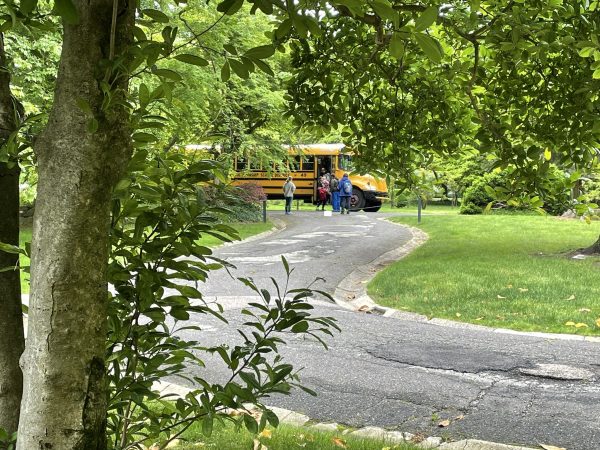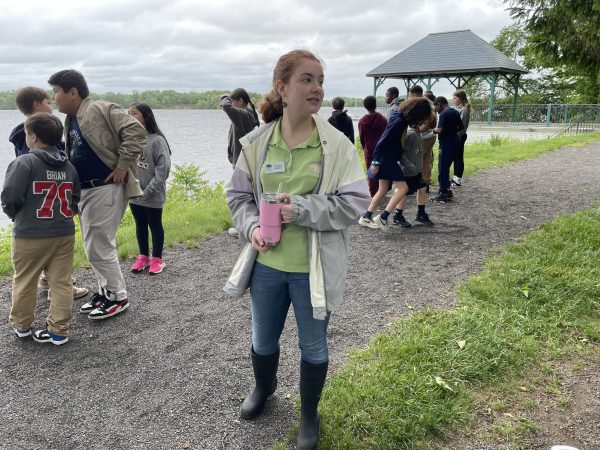If you were a raindrop being released from a cloud onto our watershed, all of our land area surrounding the Delaware River, what are 3-4 things that are in your watershed that you might land on? Where might you go after you land?
This prompt kicked off a short reflection and journal time for students on a recent field trip to historic Glen Foerd, on the Delaware River. The gathering was part of Heritage Conservancy’s Watershed Connections collaborative learning program. The program links school students in Quakertown, Tinicum, Croydon, and Philadelphia (through a partnership with Fairmount Water Works Interpretive Center) to learn about their local watershed and share results and findings from up and downstream.

Watershed Connections Collaborative Learning Program
“When thinking about the impact we have on our water from our land across large geographic areas, like the county or a watershed, we started to explore how we might help students to understand this vast concept beyond their own local area,” says Shannon Fredebaugh-Siller, Heritage Conservancy’s Community Engagement Programs Manager. “Having great school partners across the county, we reached out to local teachers and started by pairing up a classroom in Tinicum Elementary School with a classroom in Keystone Elementary School.” The program was piloted during the 2021-22 school year and students met virtually.
“Beginning in 2022-23, we were able to have the students meet in person and extend to Philadelphia through our partners at the Fairmount Water Works Interpretive Center,” says Shannon.
Ellen Freedman Schultz, the Director of Strategic Partnerships for the Fairmount Water Works (photographed with a poster below) works with Shannon and her team on the part of their program that includes Philadelphia students. “I have really enjoyed the meaningful partnership we have developed with Heritage Conservancy over several years to help students grow their understanding of watershed issues locally and regionally,” says Ellen.
In the current school year, this collaborative environmental education program serves about 210 students, with four pairings of classes across schools, eight classes total connecting four schools. The program serves 5th grade students from John Hancock Demonstration School in Philadelphia, 4th graders from Keystone Elementary School, 3rd graders from Tinicum Elementary School, and 4th and 5th graders from the United Friends School in Quakertown.

A Meeting in Glen Foerd
On a cool spring morning, students from Keystone Elementary in Bristol Township School District and John Hancock Demonstration School in Philadelphia met up for a joint field trip at historic Glen Foerd. The historic home dates back to 1850, and it sits on park land that hugs the Delaware River, part of the Fairmount Park System.
Students have been studying their parts of the watershed and comparing notes, quite literally. Each kid in the program is paired with a pen pal at a different school, and they have been writing to each other, exchanging hand-written letters to share the information they collect in their local creeks. The field trip allowed the students to meet their pen pals in person.
“Prompting rich conversation between students who have never met before about important environmental concerns and solutions broadens their own perspectives on action and change, and science and promotes a sense of well-being,” says Ellen. “Just bringing them together to explore outside in the wonderful Glen Foerd setting along the Delaware River was great, but seeing them run around and chat with each other — now that was the joyful ‘work’.”

Mia (above) from Hancock School was happy to meet her watershed pen pal. She reported that the water samples she tested in her local creek had normal levels of pH, nitrates, and phosphate. “But the water has low levels of dissolved oxygen, so it’s not good for fish and other living things,” she explained. Plants and especially animals cannot live in it.

Students distilled their findings into posters that illustrated the issues they found from their field work and provided talking points for small group discussions. Students from different areas compared the issues they are finding in their communities. Heritage Conservancy educators facilitated discussions that looked at nitrogen, oxygen, and pH levels in water and how these and other factors can affect the health of waterways.
Together they discussed their concerns, identified problems that threaten the watershed, and brainstormed possible solutions.

In a large group sharing session, students presented their finding. Among the threats to the watershed they identified were:
- Runoff and water pollution from storms
- Litter and trash that blight the nearby woods and wash into waterways
- Unhealthy pH and oxygen levels in the water that threaten fish and other organisms living
- Silt and erosion in local streams

During group sharing time, the students also shared ideas and possible solutions to some of these problems:
- Planting more native plants and bushes to trap silt and other contaminants and keep them from the water
- Adding trash cans in parks and public access points near the water, so it is easier for visitors to deposit trash where it belongs
- Encouraging the use of reusable water bottles to help keep plastic out of streams and rivers
- Raising awareness with signs and other educational initiatives to help reduce the use of fertilizers and other contaminants

As part of the day’s activities, students wrote in their nature journals and enjoyed a nature meditation with Kaylyn Brindisi, Community Programs Associate (above) along the banks of the Delaware River.
“Kids really enjoy getting out of the classroom and interacting with nature,” says Kaylyn. “This type of hands-on learning makes the issues real and understandable in a way that you can’t get from books. We are teaching them the science, but they are also learning to care about the natural world and see local connections — and solutions — to bigger problems.” The program is designed to involve students in finding answers to some of the concerns their investigations uncover.

At Glen Foerd, students walked the woods nearby and explored water samples from the Delaware, looking for aquatic macroinvertebrates, tiny organisms (bugs) that live in the river water.
The day included time for sharing, time for reflection, and a lot of discussion about what a watershed is and how interconnected we are within it. The kids enjoyed being outdoors, seeing the historic mansion, and discussing the future of our watershed. The program is designed to give students hands-on experience and to help empower them to not only identify problems but find solutions for the future.
Shannon says the program has value that extends beyond environmental learning too. “The kids have been so excited and interested in learning about each other — kids who live in areas nearby. By sharing their similarities and differences and through a collective understanding that we are all united by the water and the land, this program has helped to build the students’ watershed empathy. One school even learned about the highly competitive game of Gaga from the other school and secured their first Gaga pit recently!”
These programs were made possible with support by the William Penn Foundation and contributions from the Educational Improvement Tax Credit program.
Read about Heritage Conservancy’s other environmental education and school programs.
